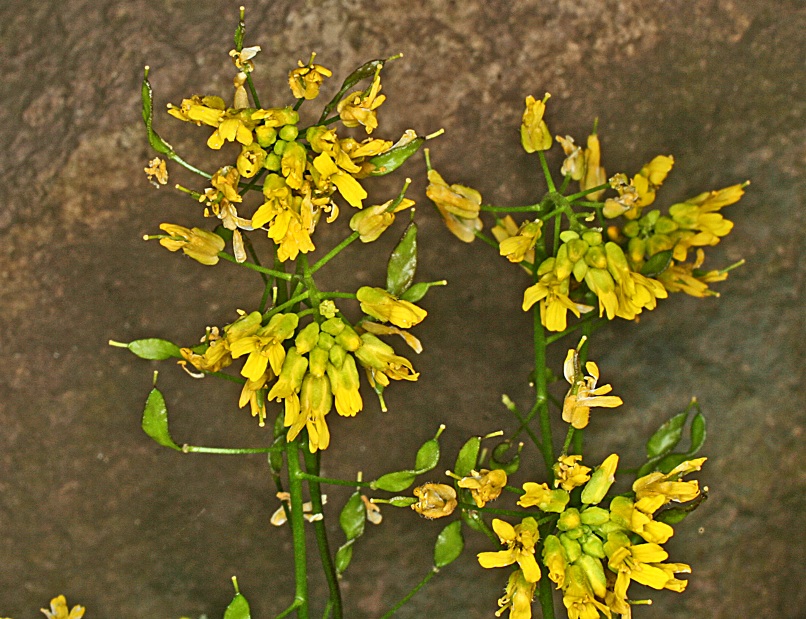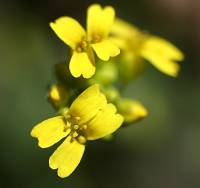
|
|
|
|
Family: Brassicaceae
Mogollon Mountain draba, more...Mogollon Mountain Whitlow-Grass, Mogollon Mountain whitlowgrass
|
Annuals, biennials, or, rarely, perennials; (short-lived); not scapose. Stems usually branched, (0.6-)1.2-2.8(-3.6) dm, pubes-cent proximally, glabrous distally, trichomes simple, 0.3-1.3 mm, and 2-4-rayed, 0.1-0.6 mm. Basal leaves rosulate; petiole (0-2 cm), densely pubescent, (trichomes simple and 2-4-rayed, not ciliate); blade spatulate to obovate or oblanceolate, (1.5-)3-8 (-10) cm × 7-25(-33) mm, margins dentate to denticulate, surfaces pubescent with long-stalked, cruciform, and fewer 2- or 3-rayed trichomes, 0.1-0.6 mm. Cauline leaves 1-3; sessile; blade oblong to ovate, margins entire, surfaces pubescent as basal. Racemes 12-40(-51)- flowered, ebracteate, elongated in fruit; rachis not flexuous, usually glabrous, rarely proximally with relatively few trichomes. Fruiting pedicels horizontal to divaricate, straight, (6-)9-18(-22) mm, usually glabrous, rarely sparsely pubescent as stem proximally. Flowers: sepals oblong, 2.5-3.5 mm, sparsely pubescent, (trichomes simple and 2-4-rayed); petals yellow, spatulate, (5-)6-8.5 × 2.2-3.5 mm; anthers oblong, 0.7-0.9 mm. Fruits linear-elliptic to elliptic-lanceolate, slightly twisted, flattened, 6-19 × 2.5-3.5 mm; valves glabrous or pubescent, trichomes simple and short-stalked, 2(-4)-rayed, 0.07-0.3 mm; ovules 24-36 per ovary; style (0.8-)1-2.2 mm. Seeds oblong, 1-1.4 × 0.7-0.8 mm. 2n = 22. Flowering Apr-May. Rock outcrops and rocky slopes in oak-pine woodlands and mixed conifer communities; 1500-2300 m; Ariz., N.Mex. Draba mogollonica is distributed in New Mexico primarily in the Mogollon and neighboring mountains in Catron, Grant, Sierra, and Socorro counties. It is reported herein for the first time from Arizona from Greenlee County, based on Barneby 2297 (NY), Rollins & Rollins 93113 (CAS, GH), and Windham 2918 (MO, UT). The only published chromosome count (n = 16, compiled in S. I. Warwick and I. A. Al-Shehbaz 2006) is erroneous; counts by M. D. Windham (unpubl.) from five populations representing all of the above-mentioned counties in Arizona and New Mexico consistently agree on n = 11.
FNA 2010 Duration: Perennial Nativity: Native Lifeform: Forb/Herb General: Herbaceous annuals, biennials, or rarely perennials, 6 cm to 3.5 m tall, stems branching, pubescent near the base, glabrous distally, hairs of simple and 2-4 rayed trichomes 0.1-1 mm long, plants with pungent, watery sap. Leaves: Alternate, basal and cauline; basal leaves in a fairly stout rosette, blades spatulate to obovate or oblanceolate, 1.5-10 cm long and 7-33 mm wide, margins dentate to denticulate, surfaces pubescent with long-stalked, cruciform or 2- or 3-rayed trichomes to 0.5 mm long, cauline oblong to ovate with entire margins, blades sessile or borne on densely pubescent petioles to 2 cm long. Flowers: Yellow, with 4 petals forming a cross or in 2 pairs, petals spatulate, 5-8.5 mm long and 2-3.5 mm wide, with notched tips, sepals 4, free, oblong, 2.5-3.5 mm, sparsely pubescent with simple to 2-4-rayed trichomes, stamens 6 with 4 long and 2 short, anthers oblong, 0.7-1 mm long, ovary solitary and superior, generally 2-chambered with a septum connecting 2 parietal placentas, ovules 24-36 per ovary, style solitary, 1-2 mm long, stigmas entire or 2-lobed, flowers borne in 12-51 flowered, ebracteate, elongated racemes at branch tips, the rachis not flexuous, usually glabrous or rarely with a few trichomes near the tips. Fruits: Linear-elliptic to elliptic-lanceolate siliques, these slightly twisted and flattened, 6-19 mm long and 2.5-3.5 mm wide, dehiscent into 2 valves and a septum, valves glabrous or pubescent with simple, 2-4 rayed trichomes, fruiting pedicels horizontal to d Ecology: Found on rock outcrops and rocky slopes in oak-pine woodlands and mixed conifer communities, from 5,000-7,500 ft (1524-2286 m); flowering April-May. Distribution: Arizona, New Mexico. Ethnobotany: Specific uses for this species are unknown, but other species in the genus have uses. Synonyms: None Editor: LCrumbacher2012 Etymology: Draba comes from the Greek drabe for "sharp" or "acrid" and referring to the burning taste of the leaves which supposedly had a medicinal value as a poultice; the meaning of mogollonica is unknown. |
This project was made possible in part by the Institute of Museum and Library Services [MG-70-19-0057-19].
Powered by Symbiota




